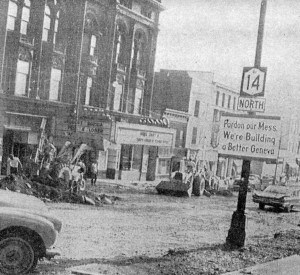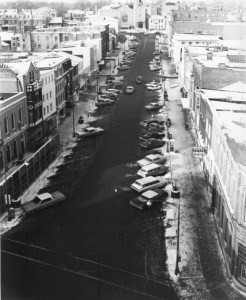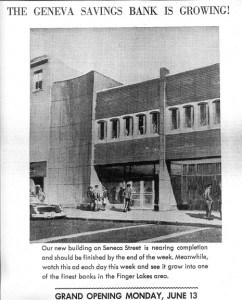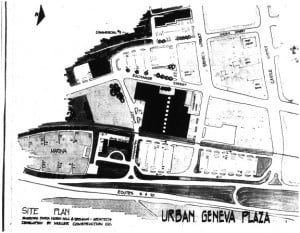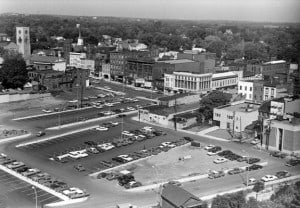Building A Better Geneva: Urban Renewal, Part II
By John Marks, Curator of Collections and Exhibits
After seven years of applying for Urban Renewal money, evaluating property conditions and values, and organizing the work, demolition began in March 1966. Razing the Seneca Street buildings was quite the event, reported on daily by the Geneva Times. Each day at 11 a.m. a photographer would snap a shot of the progress to go in that day’s paper. P.B. Oakley took photos for the Syracuse Herald-American and amateur photographer Bob Doran took extensive “before” and “after” shots.
Unlike Urban Renewal in many cities, sub-standard housing was a small portion of the demolished properties. There were seventeen houses along South Exchange and East Washington Streets that were overcrowded and had inadequate heat and plumbing for the number of occupants. The city had to find adequate housing for displaced residents before houses could be razed. They discovered that Geneva had a shortage of decent affordable housing, which had led people to live in that neighborhood to begin with. (Housing is another story for another time.)
There were other projects in and around 1966 that were not federally funded by the Urban Renewal work, but inspired by it. The city decided to invest in downtown infrastructure, replacing underground utility lines and utility poles and widening Seneca Street. By narrowing the sidewalks, Seneca Street could be widened from two lanes plus parking to four lanes.
The city planned to do the renewal work piecemeal to cause minimal disruption to downtown business. For various reasons it became necessary to have many areas torn up at once. Customers had to skirt piles of dirt in the streets and walk on plywood across open trenches. This just contributed to the attractiveness of shopping at the Hamilton Street plaza. The downtown work was completed by October and merchants welcomed back shoppers in time for the Christmas season.
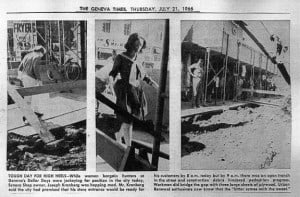 Part of downtown’s perceived problem was its old buildings. The trend toward modernizing downtown was led by four banks between 1966 and 1968. While some banks claimed a need for more office space, the construction may have been motivated by a need to match the competition.
Part of downtown’s perceived problem was its old buildings. The trend toward modernizing downtown was led by four banks between 1966 and 1968. While some banks claimed a need for more office space, the construction may have been motivated by a need to match the competition.
The Geneva Savings Bank was the first to act, tearing down two buildings on Seneca Street that were not part of the Urban Renewal project. The bank left the old Farmers and Merchants Bank on Linden Street for a new building, which is now home to the Finger Lakes Federal Credit Union.
Lincoln Rochester razed the building it was in, on the southwest corner of Seneca and Exchange Streets, and moved to temporary quarters on Exchange Street. Shortly after the Lincoln Rochester building was completed, the National Bank of Geneva tore down its building and flanking buildings on Seneca and Exchange Streets and also moved onto Exchange Street during construction.
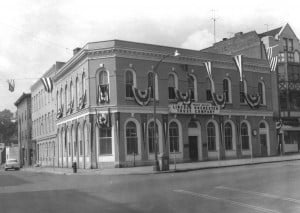
The Lincoln Rochester Trust Company building was demolished and replaced with a modern bank building (currently Community Bank) around 1966.
The Geneva Permanent Loan and Savings Association, later Geneva Federal Savings & Loan, was the only bank displaced by Urban Renewal. Unable to buy land on Seneca Street, they purchased the Kirkwood Hotel on the southwest corner of Castle and Exchange Streets, demolished it and erected a new building.
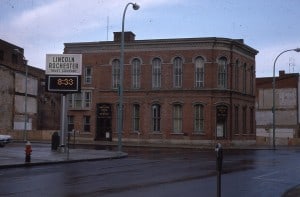
The National Bank of Geneva was demolished and replaced with a modern bank building (currently Five Star Bank) around 1966.
Now we return to wrap up the Urban Renewal story. The local Urban Renewal administration had defined three parcels to sell for development, reserving space for public parking. In 1966 there was an open competitive bidding process that only got one bid, but it was for all the parcels.
Ted Bogart of Geneva and Emil Muller of Rochester, doing business as Bomil, Inc., had big plans for the parcels as well as property they purchased on the east side of South Exchange Street. Their project included stores on Seneca Street, a supermarket, a department store and smaller stores with underground parking, a 50-unit motel, and a marina. The one provision of the plan was that a new access to the arterial be made along East Washington Street.
This proved to be the deal breaker. The state refused to allow the new access (it was eventually created in the late 1980s when the arterial was redesigned) and after four years of negotiating, Emil Muller walked away from the project. He also donated the twelve acres on the east side of South Exchange Street to the federal Office of Equal Opportunity (OEO), to be used by the Geneva City School District and HeadStart.
While not part of the Urban Renewal area, the city considered that land to be integral to redevelopment of downtown. The city spent the next eighteen months flying to Washington and arguing the importance of that parcel. OEO gave the city a quit claim deed to the land, but in 1979, according to the Finger Lakes Times, the city was still trying to gain clear title to the land so it could be developed. Although title was accomplished and many developers have shown interest, there is still a vacant lot on South Exchange Street.
While Geneva ended up with a giant parking lot, it was not the city’s intent in the 1960s. There was simply a lack of interest in new downtown development. In hindsight, it may not have been the worst outcome. The Smith Opera House, the city’s skating rink, and numerous new restaurants draw more people downtown. On a weekend night, if there are two or more events plus people out for dinner, there are still not enough parking spaces.
Building A Better Geneva: Urban Renewal, Part I
Geneva’s Stories: Urban Renewal in Geneva, Part I
Geneva’s Stories: Urban Renewal in Geneva, Part II

